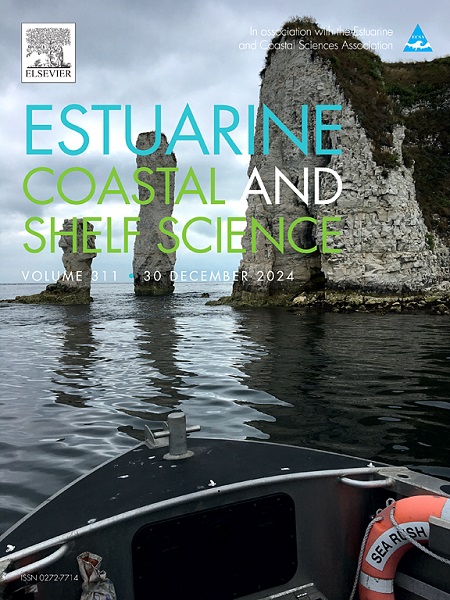通过潮位、相位和倾斜浪涌的镜头,研究英国海岸周围的非线性潮汐与浪涌的相互作用
IF 2.6
3区 地球科学
Q1 MARINE & FRESHWATER BIOLOGY
引用次数: 0
摘要
极端海平面导致的沿海洪水是对英国海岸线的重大威胁。极端海平面的主要贡献是潮汐和浪涌的结合,了解这些成分如何相互作用对于评估海岸的极端海平面至关重要。在这里,我们利用英国的整个观测潮汐测量网、近500年的模型和2013/14年的模式运行,分析了偏潮和潮高、非潮剩余和潮相、非潮剩余和潮位的相互作用,并对这些相互作用进行了人为调整,以检验风暴到达时间如何影响这些相互作用。我们发现,在大多数地点,潮涌相互作用的水平对极值阈值的大小和聚类窗口的大小相对不敏感。实测数据比模拟数据显示出更大程度的相互作用,尽管歪斜浪涌和潮汐高潮之间的相互作用很少,但在非潮汐残余和天文潮汐之间存在相当大的潮汐-浪涌相互作用,最大的是潮汐阶段。在英国周围,极端的非潮汐余量通常发生在潮汐高潮前1至5小时,以及在平均潮位或低于平均潮位的潮位。当人为地改变风暴到达时间时,英国周围相互作用的总体变化相对较小,尽管在较小的空间尺度上可以看到变化,但歪斜浪涌和非潮汐剩余极大值分别出现在相似的潮汐高潮、潮相和潮位上。我们的研究结果促进了对英国周围非线性潮涌相互作用的理解,这对于准确估计极端海平面概率至关重要,从而保护海岸线免受沿海洪水的侵袭。本文章由计算机程序翻译,如有差异,请以英文原文为准。
Non-linear tide-surge interactions around the coast of the UK through the lens of tidal level, phase, and skew surge
Coastal flooding, driven by extreme sea levels, is a significant threat to the coastline of the United Kingdom. The primary contribution to extreme sea levels is the combination of tide and surge and understanding how these components interact is critical to assessing extreme sea levels at the coast. Here, we analyse the interactions of skew surge and tidal high water, non-tidal residual and tidal phase, and non-tidal residual and tidal level using the entire observational tide gauge network of the UK, a near 500-year model, and a model run of 2013/14 with an artificially adjusted forcing to examine how storm arrival time impacts these interactions. We show that the levels of tide-surge interaction at most sites are relatively insensitive to the magnitude of the extreme value threshold and the declustering window size. Measured data show greater levels of interaction than modelled data and although there is little interaction between skew surge and tidal high water, there are sizeable tide-surge interactions between the non-tidal residual and the astronomical tide, the largest being for tidal phase. Around the UK, extreme non-tidal residuals generally occur favourably between 1 and 5 h before tidal high water and at tidal levels that are at, or below, the average tidal level. When storm arrival time is artificially shifted, the overall change in interaction around the UK is relatively small, with skew surge and non-tidal residual maxima occurring at similar respective tidal high waters, tidal phases, and tidal levels, although variation is seen on smaller spatial scales. Our findings advance the understanding of non-linear tide-surge interactions around the UK, which is essential for the accurate estimation of extreme sea level probabilities and thus the defence of the coastline against coastal flooding.
求助全文
通过发布文献求助,成功后即可免费获取论文全文。
去求助
来源期刊
CiteScore
5.60
自引率
7.10%
发文量
374
审稿时长
9 months
期刊介绍:
Estuarine, Coastal and Shelf Science is an international multidisciplinary journal devoted to the analysis of saline water phenomena ranging from the outer edge of the continental shelf to the upper limits of the tidal zone. The journal provides a unique forum, unifying the multidisciplinary approaches to the study of the oceanography of estuaries, coastal zones, and continental shelf seas. It features original research papers, review papers and short communications treating such disciplines as zoology, botany, geology, sedimentology, physical oceanography.

 求助内容:
求助内容: 应助结果提醒方式:
应助结果提醒方式:


